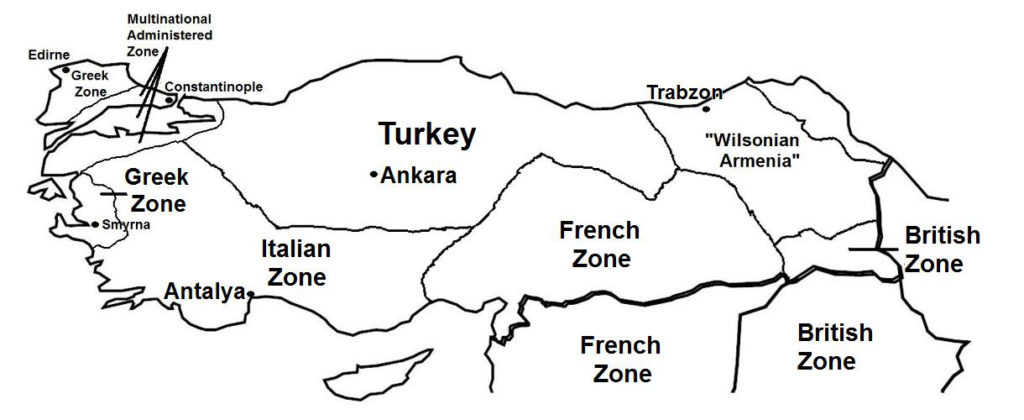On August 26, 1922, the Turkish Army launched its long awaited counter-attack against the Greek forces. Holding a 3:1 numerical and considerable material advantage, the Turkish forces easily overpowered and expelled the Greek Army from Anatolia. On September 9, the Turkish Army reached the Aegean cost with the recapture of Smyrna (present-day Izmir). On September 18, Erdek and Biga were taken, which ended the fighting. By then, Greek forces had ceased to be an effective fighting unit, and demoralization and dissension had forced a hasty, disorganized retreat. In the aftermath, the Greeks withdrew from western Anatolia.

The Greco-Turkish War formed one part of the Turkish War of Independence.
(Taken from Turkish War of Independence – Wars of the 20th Century – Volume 3)
Rise of the Turkish Independence Movement Under the armistice agreement, the Ottoman government was required to disarm and demobilize its armed forces. On April 30, 1919, Mustafa Kemal, a general in the Ottoman Army, was appointed as the Inspector-General of the Ottoman Ninth Army in Anatolia, with the task of demobilizing the remaining forces in the interior. Kemal was a nationalist who opposed the Allied occupation, and upon arriving in Samsun on May 19, 1919, he and other like-minded colleagues set up what became the Turkish Nationalist Movement.
Contact was made with other nationalist politicians and military officers, and alliances were formed with other nationalist organizations in Anatolia. Military units that were not yet demobilized, as well as the various armed bands and militias, were instructed to resist the occupation forces. These various nationalist groups ultimately would merge to form the nationalists’ “National Army” in the coming war. Weapons and ammunitions were stockpiled, and those previously surrendered were secretly taken back and turned over to the nationalists.
On June 21, 1919, Kemal issued the Amasya Circular, which declared among other things, that the unity and independence of the Turkish state were in danger, that the Ottoman government was incapable of defending the country, and that a national effort was needed to secure the state’s integrity. As a result of this circular, Turkish nationalists met twice: at the Erzerum Congress (July-August 1991) by regional leaders of the eastern provinces, and at the Sivas Congress (September 1919) of nationalist leaders from across Anatolia. Two important decisions emerged from these meetings: the National Pact and the “Representative Committee”.
The National Pact set forth the guidelines for the Turkish state, including what constituted the “homeland of the Turkish nation”, and that the “country should be independent and free, all restrictions on political, judicial, and financial developments will be removed”. The “Representative Committee” was the precursor of a quasi-government that ultimately took shape on May 3, 1920 as the Turkish Provisional Government based in Ankara (in central Anatolia), founded and led by Kemal.
Kemal and his Representative Committee “government” challenged the continued legitimacy of the national government, declaring that Constantinople was ruled by the Allied Powers from whom the Sultan had to be liberated. However, the Sultan condemned Kemal and the nationalists, since both the latter effectively had established a second government that was a rival to that in Constantinople.
In July 1919, Kemal received an order from the national authorities to return to Constantinople. Fearing for his safety, he remained in Ankara; consequently, he ceased all official duties with the Ottoman Army. The Ottoman government then laid down treason charges against Kemal and other nationalist leaders; tried in absentia, he was declared guilty on May 11, 1920 and sentenced to death.
Initially, British authorities played down the threat posed by the Turkish nationalists. Then when the Ottoman parliament in Constantinople declared its support for the nationalists’ National Pact and the integrity of the Turkish state, the British violently closed down the legislature, an action that inflicted many civilian casualties. The next month, the Sultan affirmed the dissolution of the Ottoman parliament.
Many parliamentarians were arrested, but many others escaped capture and fled to Ankara to join the nationalists. On April 23, 1920, a new parliament called the Grand National Assembly convened in Ankara, which elected Kemal as its first president.
British authorities soon realized that the nationalist movement threatened the Allied plans on the Ottoman Empire. From civilian volunteers and units of the Sultan’s Caliphate Army, the British organized a militia, which was tasked to defeat the nationalist forces in Anatolia. Clashes soon broke out, with the most intense taking place in June 1920 in and around Izmit, where Ottoman and British forces defeated the nationalists. Defections were widespread among the Sultan’s forces, however, forcing the British to disband the militia.
The British then considered using their own troops, but backed down knowing that the British public would oppose Britain being involved in another war, especially one coming right after World War I. The British soon found another ally to fight the war against the nationalists – Greece. On June 10, 1920, the Allies presented the Treaty of Sevres to the Sultan. The treaty was signed by the Ottoman government but was not ratified, since war already had broken out.
In the coming war, Kemal crucially gained the support of the newly established Soviet Union, particularly in the Caucasus where for centuries, the Russians and Ottomans had fought for domination. This Soviet-Turkish alliance resulted from both sides’ condemnation of the Allied intervention in their local affairs, i.e. the British and French enforcing the Treaty of Sevres on the Ottoman Empire, and the Allies’ open support for anti-Bolshevik forces in the Russian Civil War.
